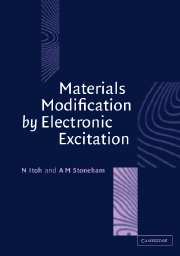Book contents
- Frontmatter
- Contents
- Preface
- 1 Concepts: Excitation, polarons and electronic structure
- 2 Energy deposition and redistribution in solids
- 3 Electron–lattice coupling and its consequences
- 4 Self-trapping
- 5 Local lattice modification by electronic excitation of halides
- 6 Local lattice modification by electronic excitation of crystalline insulating oxides
- 7 Local lattice modification of semiconductors by electronic excitation
- 8 Local lattice modification of amorphous materials by electronic excitation
- 9 Atomic emission and surface modification
- 10 Interface reactions induced by electronic excitation
- 11 High excitation intensities
- 12 Applications of materials modification by excitation
- References
- Index
6 - Local lattice modification by electronic excitation of crystalline insulating oxides
Published online by Cambridge University Press: 11 August 2009
- Frontmatter
- Contents
- Preface
- 1 Concepts: Excitation, polarons and electronic structure
- 2 Energy deposition and redistribution in solids
- 3 Electron–lattice coupling and its consequences
- 4 Self-trapping
- 5 Local lattice modification by electronic excitation of halides
- 6 Local lattice modification by electronic excitation of crystalline insulating oxides
- 7 Local lattice modification of semiconductors by electronic excitation
- 8 Local lattice modification of amorphous materials by electronic excitation
- 9 Atomic emission and surface modification
- 10 Interface reactions induced by electronic excitation
- 11 High excitation intensities
- 12 Applications of materials modification by excitation
- References
- Index
Summary
Basic phenomena
Oxides and halides: Basics and similarities
Our discussion of halides showed the central importance of self-trapped excitons and of the processes which compete with self-trapping. When we turn to oxides, we have to ask whether the same classes of process occur. Moreover, we cannot confine ourselves to ideal single crystals, but should assess the situation for oxide ceramics, since these polygrannular materials are typical of functional materials in technology. In this chapter we emphasise materials modification in oxides due to excitation, rather than knock-ons, and attempt to understand the mechanisms. For many technological materials, the mechanisms are not always clear. Most probably, there are further complications, such as diffusion, chemical reactions, and changes of phase.
Excitons are self-trapped in some oxides. Yet there seem to be no cases of defect formation as a consequence of a single bandgap electronic excitation, even when the exciton is self-trapped. Why is this? One possibility is simply that there is a potential barrier between the self-trapped exciton and the defect pair. If this potential barrier could be overcome or bypassed, electronic mechanisms for defect formation would be possible in oxides. If this were the explanation, then the differences between halides and oxides would be differences of degree only. However, there are several other common differences between oxides and halides, and these may be important.
- Type
- Chapter
- Information
- Materials Modification by Electronic Excitation , pp. 224 - 244Publisher: Cambridge University PressPrint publication year: 2000



